
Hula is a Polynesian dance form accompanied by chant (Oli) or song. It was developed in the Hawaiian Islands by the Polynesians who originally settled there. The hula dramatizes or portrays the words of the oli or mele in a visual dance form.

The traditional music of Tuvalu consists of dances, including fatele, fakanau and fakaseasea. The influence of the Samoan missionaries sent to Tuvalu by the London Missionary Society from the 1860s resulted in the suppression of songs about the traditional religions or magic and many songs were lost. As the influence of the missionaries diminished in the 20th century the traditional dances were revived and the siva dance tradition from Samoa also became popular. The fatele, in its modern form, is performed at community events and to celebrate leaders and other prominent individuals.

A lavalava, also known as an 'ie, short for 'ie lavalava, is an article of daily clothing traditionally worn by Polynesians and other Oceanic peoples. It consists of a single rectangular cloth worn similarly to a wraparound skirt or kilt. The term lavalava is both singular and plural in the Samoan language.
The traditional culture of Samoa is a communal way of life based on Fa'a Samoa, the unique socio-political culture. In Samoan culture, most activities are done together. The traditional living quarters, or fale (houses), contain no walls and up to 20 people may sleep on the ground in the same fale. During the day, the fale is used for chatting and relaxing. One's family is viewed as an integral part of a person's life. The aiga or extended family lives and works together. Elders in the family are greatly respected and hold the highest status, and this may be seen at a traditional Sunday umu.

Samoans or Samoan people are the indigenous Polynesian people of the Samoan Islands, an archipelago in Polynesia, who speak the Samoan language. The group's home islands are politically and geographically divided between the Independent State of Samoa and American Samoa, an unincorporated territory of the United States of America. Though divided by national border, the culture and language are the same.

Polynesian culture is the culture of the indigenous peoples of Polynesia who share common traits in language, customs and society. The development of Polynesian culture is typically divided into four different historical eras:
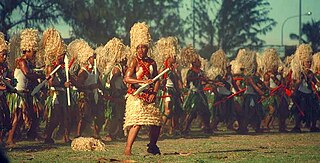
The Tongan archipelago has been inhabited for perhaps 3000 years, since settlement in late Lapita times. The culture of its inhabitants has surely changed greatly over this long time period. Before the arrival of European explorers in the late 17th and early 18th centuries, the Tongans were in frequent contact with their nearest Oceanic neighbors, Fiji and Samoa. In the 19th century, with the arrival of Western traders and missionaries, Tongan culture changed dramatically. Some old beliefs and habits were thrown away and others adopted. Some accommodations made in the 19th century and early 20th century are now being challenged by changing Western civilization. Hence Tongan culture is far from a unified or monolithic affair, and Tongans themselves may differ strongly as to what it is "Tongan" to do, or not do. Contemporary Tongans often have strong ties to overseas lands. They may have been migrant workers in New Zealand, or have lived and traveled in New Zealand, Australia, or the United States. Many Tongans now live overseas, in a Tongan diaspora, and send home remittances to family members who prefer to remain in Tonga. Tongans themselves often have to operate in two different contexts, which they often call anga fakatonga, the traditional Tongan way, and anga fakapālangi, the Western way. A culturally adept Tongan learns both sets of rules and when to switch between them.
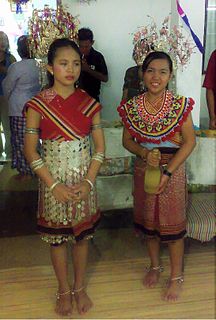
Gawai Dayak is an annual festival celebrated by the Dayak people in Sarawak, Malaysia and West Kalimantan, Indonesia on 1 and 2 June. It is a public holiday in Sarawak and is both a religious and a social occasion recognised since 1957.
Siva Samoa is the Samoan term for a Samoan dance.
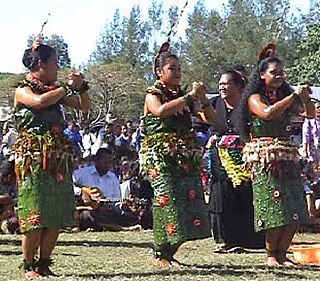
The tauʻolunga is a traditional Tongan dance. The type of dance is comparable with (some) Hawaiʻian hula or the Tahitian ʻaparima.
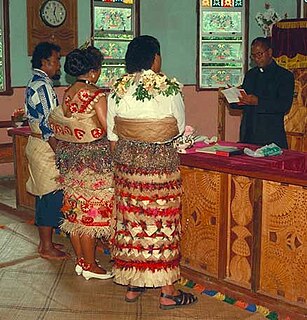
A taʻovala is an article of Tongan dress, a mat wrapped around the waist, worn by men and women, at all formal occasions, much like the tie for men in the European and North American culture. The ta'ovala is also commonly seen among the Fijian Lau Islands, a region once heavily influenced by Tongan hegemony and cultural diffusion.
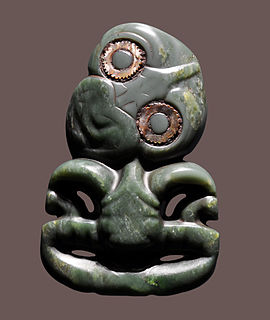
Jewellery making in the Pacific started later than in other areas, due to relatively recent human settlement. Early Polynesian jewellery, which was made of bone, wood and other natural materials, has not survived. The precise start of island jewellery-making is difficult to pinpoint, due to many of the island nations' founders migrating there from other areas, such as Tahiti.

The fire knife is a traditional Samoan cultural implement that is used in ceremonial dances. It was originally composed of a machete wrapped in towels on both ends with a portion of the blade exposed in the middle. Tribal performers of fire knife dancing dance while twirling the knife and doing other acrobatic stunts. The towels are set afire during the dances, hence the name.

Māori traditional textiles are the indigenous textiles of the Māori people of New Zealand. The organisation Te Roopu Raranga Whatu o Aotearoa, the national Māori weavers' collective, aims to preserve and foster the skills of making and using these materials.

An ʻie tōga is a special finely woven mat that is an important item of cultural value in Samoa. They are commonly referred to in English as "fine mats" although they are never used as mats as they only have a purely cultural value. ʻIe tōga are valued by the quality of the weave and the softness and shine of the material. They are made by women and form an important part of their role, identity and skill in their community.
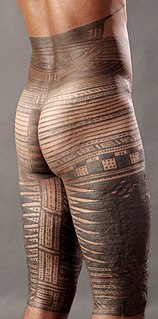
The Pe'a is the popular name of the traditional male tatau (tattoo) of Samoa, also known as the malofie, a term used in the Samoan language chiefly vocabulary and "respect" register.

The architecture of Samoa is characterised by openness, with the design mirroring the culture and life of the Samoan people who inhabit the Samoa Islands. Architectural concepts are incorporated into Samoan proverbs, oratory and metaphors, as well as linking to other art forms in Samoa, such as boat building and tattooing. The spaces outside and inside of traditional Samoan architecture are part of cultural form, ceremony and ritual.
Wood carving is a common art form in the Cook Islands. Sculpture in stone is much rarer although there are some excellent carvings in basalt by Mike Tavioni. The proximity of islands in the southern group helped produce a homogeneous style of carving but which had special developments in each island. Rarotonga is known for its fisherman's gods and staff-gods, Atiu for its wooden seats, Mitiaro, Mauke and Atiu for mace and slab gods and Mangaia for its ceremonial adzes. Most of the original wood carvings were either spirited away by early European collectors or were burned in large numbers by missionary zealots.
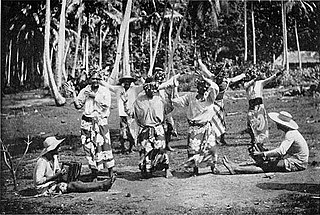
Tahitian drumming is a style of drumming native to Tahiti and French Polynesia. Tahitian drumming and dance have become symbols of Polynesian heiva to the western world. Heiva is the Tahitian term for entertainment. This authentic performance symbolizes the past and present state of social hierarchies within the community and the island. There has been a significant amount of change to Tahitian drum dancing within the past fifty years. These changes have come from many different aspects of Polynesian society. However, many of them stem from the broader outreach of this tradition to the rest of the world. This music has served as inspiration for many other styles across the globe, especially in other areas of the Pacific.
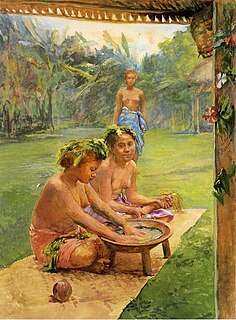
Wallis and Futuna, an overseas territory of France in Oceania has a rich Polynesian culture that is very similar to the cultures of its neighbouring nations Samoa and Tonga. The Wallisian and Futunan cultures share very similar components in language, dance, cuisine and modes of celebration.


















